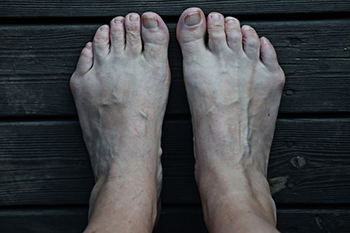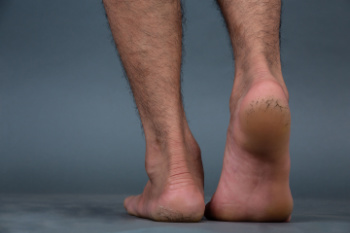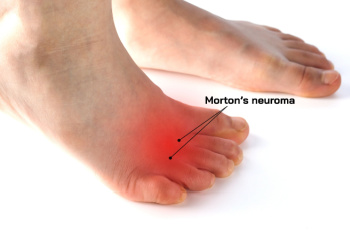Items filtered by date: May 2025
Facts About Tailor's Bunion

A tailor's bunion, also known as a bunionette, is a bony prominence that forms on the outside of the foot at the base of the little toe. This condition occurs when the fifth metatarsal bone shifts outward while the little toe moves inward, creating a painful bump. It is often caused by inherited foot structure, poor footwear choices, or abnormal foot mechanics. Symptoms may include redness, swelling, and discomfort when wearing shoes. Tailor's bunions can interfere with daily activities and limit footwear options. Treatment usually involves wearing wider shoes, and using padding or orthotics for support. In more severe cases, surgery may be necessary. If you have a tailor’s bunion, it is suggested that you confer with a podiatrist who can offer effective relief tips that can ease discomfort.
If you are suffering from bunion pain, contact James Tyler Vestile, DPM of Foot and Ankle Centers of Indiana. Our doctor can provide the care you need to keep you pain-free and on your feet.
What Is a Bunion?
Bunions are painful bony bumps that usually develop on the inside of the foot at the joint of the big toe. As the deformity increases over time, it may become painful to walk and wear shoes. Women are more likely to exacerbate existing bunions since they often wear tight, narrow shoes that shift their toes together. Bunion pain can be relieved by wearing wider shoes with enough room for the toes.
Causes
- Genetics – some people inherit feet that are more prone to bunion development
- Inflammatory Conditions - rheumatoid arthritis and polio may cause bunion development
Symptoms
- Redness and inflammation
- Pain and tenderness
- Callus or corns on the bump
- Restricted motion in the big toe
In order to diagnose your bunion, your podiatrist may ask about your medical history, symptoms, and general health. Your doctor might also order an x-ray to take a closer look at your feet. Nonsurgical treatment options include orthotics, padding, icing, changes in footwear, and medication. If nonsurgical treatments don’t alleviate your bunion pain, surgery may be necessary.
If you have any questions, please feel free to contact our office located in Tipton, IN . We offer the newest diagnostic and treatment technologies for all your foot care needs.
Cracked Heels and Vitamin Deficiencies

Cracked heels can be more than just a cosmetic concern. They may signal an underlying nutritional issue, particularly a vitamin deficiency. Vitamins play an essential role in maintaining skin health and elasticity. When the body lacks essential nutrients, such as vitamin E, vitamin C, and certain B vitamins, the skin may become dry, rough, and prone to cracking. These deficiencies affect the skin's ability to repair itself and retain moisture, which leads to fissures around the heels. People with poor diets or malabsorption issues are at greater risk. In addition to moisturizing and wearing supportive footwear, addressing any nutritional shortfalls through diet or supplements may help improve the condition of the heels. Cracked heels can be uncomfortable and unsightly. If you have developed this condition, it is suggested that you contact a podiatrist who can offer effective treatment solutions, which may include prescribed medication.
Cracked heels are unsightly and can cause further damage to your shoes and feet. If you have any concerns, contact James Tyler Vestile, DPM from Foot and Ankle Centers of Indiana. Our doctor can provide the care you need to keep you pain-free and on your feet.
Cracked Heels
Cracked heels appear unappealing and can make it harder for you walk around in sandals. Aside from looking unpleasant, cracked heels can also tear stockings, socks, and wear out your shoes. There are several methods to help restore a cracked heel and prevent further damage.
How Do You Get Them?
Dry skin is the number one culprit in creating cracked heels. Many athletes, walkers, joggers, and even swimmers suffer from cracked heels. Age and skin oil production play a role to getting cracked heels as well.
Promote Healing
Over the counter medicines can help, especially for those that need instant relief or who suffer from chronic dry feet.
Wear Socks – Wearing socks with medicated creams helps lock in moisture.
Moisturizers – Applying both day and night will help alleviate dryness which causes cracking.
Pumice Stones – These exfoliate and remove dead skin, which allows for smoother moisturizer application and better absorption into the skin.
Change in Diet
Eating healthy with a well-balanced diet will give the skin a fresh and radiant look. Your body responds to the kinds of food you ingest. Omega-3 fatty acids and zinc supplements can also revitalize skin tissue.
Most importantly, seek professional help if unsure how to proceed in treating cracked heels. A podiatrist will help you with any questions or information needed.
If you have any questions, please feel free to contact our office located in Tipton, IN . We offer the newest diagnostic and treatment technologies for all your foot care needs.
Conditions Treated by Podiatrists

Podiatry is a branch of medicine focused on diagnosing, treating, and preventing conditions related to the feet, ankles, and lower legs. A podiatrist is a medical specialist trained to manage a wide range of issues affecting this part of the body. These can include common concerns, such as heel pain, bunions, and ingrown toenails, as well as more complex conditions like diabetic foot problems, nerve disorders, and structural deformities. Podiatrists also treat sports injuries, provide guidance on proper footwear, and help manage chronic conditions like arthritis or circulation issues. Their care plays a vital role in improving mobility, relieving pain, and supporting overall health. Regular visits to a podiatrist can help detect problems early and promote long-term foot and ankle wellness. If you have any type of foot pain, it is strongly suggested that you visit a podiatrist who can accurately diagnose and treat various foot conditions.
If you are dealing with pain in your feet and ankles, you may want to seek help from a podiatrist. Feel free to contact James Tyler Vestile, DPM from Foot and Ankle Centers of Indiana. Our doctor can provide the care you need to keep you pain-free and on your feet.
What Is a Podiatrist?
A podiatrist is a doctor of podiatric medicine who diagnoses and treats conditions of the foot, ankle, and related structures of the leg. Your podiatrist may specialize in a certain field such as sports medicine, wound care, pediatrics, and diabetic care. Podiatrists have the ability to become board certified through training, clinical experience, and then taking an exam.
What Do Podiatrists Do?
On a daily basis, a podiatrist may perform the following activities:
- Diagnose foot ailments such as ulcers, tumors, fractures, etc.
- Use innovative methods to treat conditions
- Use corrective orthotics, casts, and strappings to correct deformities
- Correct walking patterns and balance
- Provide individual consultations to patients
It is very important that you take care of your feet. It’s easy to take having healthy feet for granted, however foot problems tend to be among the most common health conditions. Podiatrists can help diagnose and treat a variety of feet related conditions, so it is crucial that you visit one if you need assistance.
If you have any questions please feel free to contact our office located in Tipton, IN . We offer the newest diagnostic and treatment technologies for all your foot and ankle needs.
Heel Pain Can Be Treated!
Symptoms and Treatment of Morton’s Neuroma

Morton's neuroma is a painful foot condition that occurs when a nerve becomes compressed between the metatarsal bones, typically between the third and fourth toes. Patients may feel a sharp, burning, or stabbing pain in the ball of the foot, along with tingling, cramping, or numbness in the toes. It may feel as though a small object, such as a pebble, is stuck inside the shoe. As the condition progresses, the pain may become more frequent and intense. A podiatrist can diagnose Morton's neuroma through a physical exam and specific compression tests, sometimes supported by imaging. Treatment may involve custom shoe inserts to reduce pressure on the affected nerve or corticosteroid injections to reduce inflammation. If these measures do not relieve symptoms, surgery might be required to either remove the thickened nerve tissue or release the ligament causing the compression. If you experience symptoms of Morton's neuroma, it is suggested that you schedule an appointment with a podiatrist for appropriate treatment.
Morton’s neuroma is a very uncomfortable condition to live with. If you think you have Morton’s neuroma, contact James Tyler Vestile, DPM of Foot and Ankle Centers of Indiana. Our doctor will attend to all of your foot care needs and answer any of your related questions.
Morton’s Neuroma
Morton's neuroma is a painful foot condition that commonly affects the areas between the second and third or third and fourth toe, although other areas of the foot are also susceptible. Morton’s neuroma is caused by an inflamed nerve in the foot that is being squeezed and aggravated by surrounding bones.
What Increases the Chances of Having Morton’s Neuroma?
- Ill-fitting high heels or shoes that add pressure to the toe or foot
- Jogging, running or any sport that involves constant impact to the foot
- Flat feet, bunions, and any other foot deformities
Morton’s neuroma is a very treatable condition. Orthotics and shoe inserts can often be used to alleviate the pain on the forefront of the feet. In more severe cases, corticosteroids can also be prescribed. In order to figure out the best treatment for your neuroma, it’s recommended to seek the care of a podiatrist who can diagnose your condition and provide different treatment options.
If you have any questions, please feel free to contact our office located in Tipton, IN . We offer the newest diagnostic and treatment technologies for all your foot care needs.

